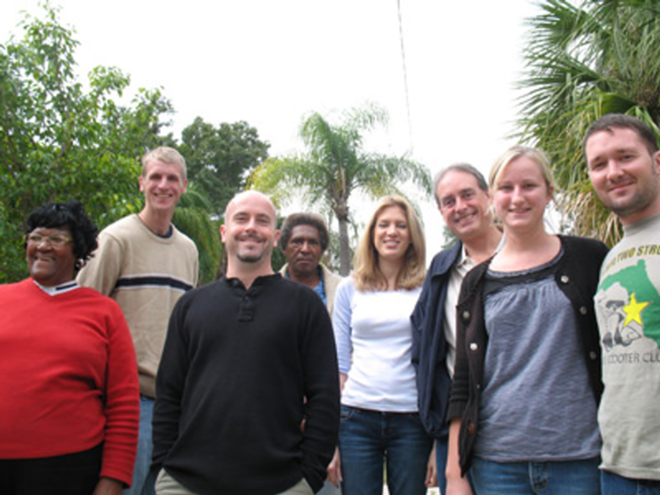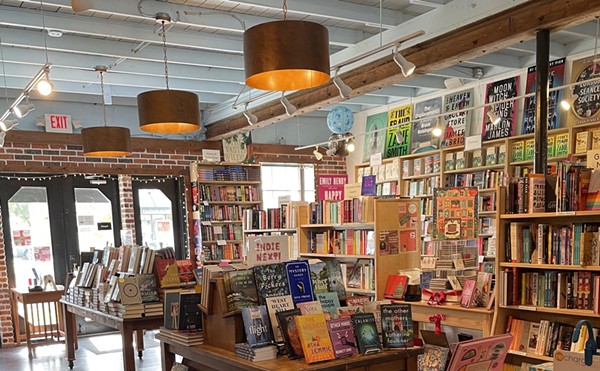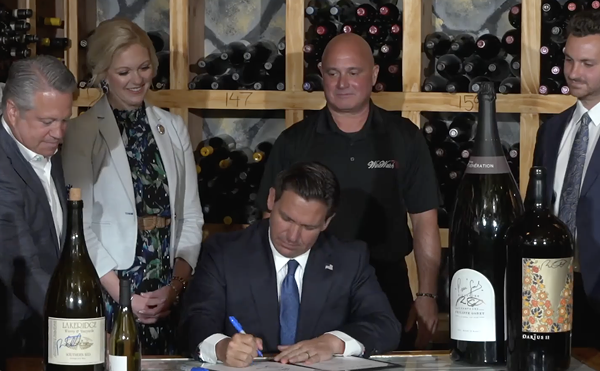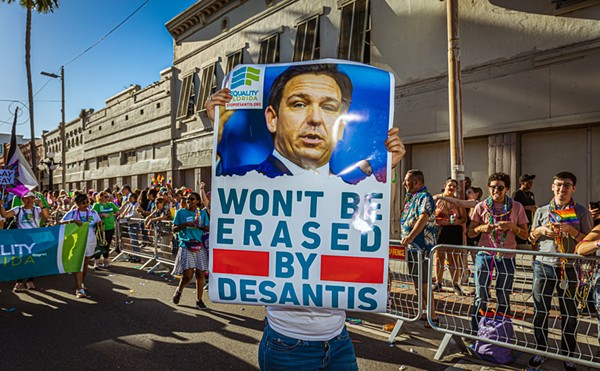
On a bright Saturday morning, eight residents of St. Petersburg's Bartlett Park neighborhood gather in the renovated home of Julie Richey and Stewart Nicol. The former vice president of the neighborhood association, Scott Swift, is here. So are Lindsay Myers, editor of the Bartlett Park Newsletter, and John and Rosemary Kitchen, both elected officers in the association. The Kitchens are black, and longtime residents; the others are white or Hispanic (including one Cuban and one Argentinean couple), and moved to Bartlett Park in the last three years.
Over crumbly coffeecake, the group shares the successes, failures and frustrations of local activism. But then they get down to business: They are meeting today to plot a defection.
For the last year, these residents have labored to improve Bartlett Park. They helped to form a Crime Watch group, started a newsletter, sponsored litter clean-ups and enforced codes regulations in this oft-forgotten part of St. Pete just south of downtown.
But trying to improve the neighborhood, as Brian Wyllie puts it, is "like pushing a lead ball."
Wyllie and the others say the more they work toward making Bartlett Park a safer, cleaner, more hospitable place to live, the harder some in the association push back.
"To those of us that are new, [revitalizing the neighborhood] is still a very slow process," Swift says. "We do a project every three to four months. Everyone else in the city does one every two weeks."
So this group of eight — and two other relatively new residents who couldn't make the meeting — have formed their own organization: the Buena Vista Neighborhood Association, which will focus on the area between Fourth and Martin Luther King streets and 14th and 18th avenues, approximately half of Bartlett Park.
"We're going to continue to do positive things for the neighborhood," Swift says. "But the association has served as an obstacle."
As we enter 2008, I'm reminded of the oft-used maxim: the more things change, the more they stay the same. Bartlett Park's fissures, which I first wrote about last spring ("Here Comes the Neighborhood," April 18, 2007), aren't the only example. The frenzy over drug paraphernalia that overtook Pinellas County in 2006 has spread statewide. And the St. Petersburg City Council is still pondering largely meaningless ordinances directed at the city's homeless.
Here's our first set of updates from stories I wrote about in 2006 and 2007; stay tuned next week for a second installment.
The Bartlett split
Change has never come easily to Bartlett Park. In the 1970s, white flight turned the 30-block neighborhood into a predominantly African-American district. When the crack epidemic hit St. Pete in the '80s, Bartlett Park regressed to a crime haven, sheltering the most powerful drug dealer in Tampa Bay. Throughout the '90s, the neighborhood was synonymous with poverty.
Then, during the latest housing boom, investors and homeowners eyed the area, buying up the cheap housing stock and filling vacant lots with new homes. But progress created another kind of discord.
As the neighborhood inched toward revitalization, some longtime black residents worried aloud that the influx of mostly white newcomers was pushing them out. They complained change was happening too fast. New residents and investors disagreed and wondered why anyone would question their improvement efforts.
After the April Creative Loafing story, several residents said relations between neighbors warmed, leading to the launch of several projects: the first Crime Watch group in 15 years, a newsletter and numerous block parties and beautification projects.
But tension remained.
Newcomers complained changes were coming too slow. Myers, the Bartlett Park newsletter editor who moved to the neighborhood in April, says there were disagreements over putting the city's codes enforcement phone number in the newsletter. Other efforts, like holding crime watch meetings in new residents' backyards, were also criticized, she says.
But worse, newcomers say, some longtime association members viewed their neighborhood activism suspiciously. And this suspicion manifested itself in racial terms. "White takeover" has been a phrase heard often.
"I feel vilified just for living here," Myers says.
And during neighborhood association meetings, newer members felt excluded from decision-making, says Swift.
"[Some members of the association] oppose the credibility of anybody new," he says. "You can't say, 'I've been here 30 years and you've been here one year and your opinion doesn't matter.'"
Discord came to a head at the December association meeting when elections were held, and fierce arguments arose over who was allowed to vote. In the end, Swift resigned from his post as vice president and walked out.
"It makes people uncomfortable to see all this hostility," says Tom Tito, the association's president, who is white. "A lot of black residents have stopped coming [to the association meetings]. They don't want to disagree, so they just don't come."
That, in turn, creates an association in a predominantly black neighborhood led largely by white new residents. Tito says this can give the rest of the neighborhood a bad perception of the work the association does.
"Not having enough African-American leadership in the community is a problem," he says.
Tito argues that differences over issues like codes have pushed older black residents away from the association.
"You have neighbors turning in neighbors," he says.
The Buena Vista members disagree that code enforcement is driving people away from the organization, and contend that rumors are dividing the neighborhood.
"We got to let them know what they're hearing is wrong," Swift says.
So, instead of fighting within the association, these residents split to make a difference in their own way.
"This isn't a secret society and it isn't personal," says Myers. "They can join us for positive projects. We just have different ideas of what a community is."
The Paraphernalia Crackdown
Stoners and tobacco enthusiasts, put down your bongs for a moment, I have a major buzz kill: Pinellas County's 2006 crackdown on drug paraphernalia has spread statewide.
Earlier this year, the state Legislature passed a bill establishing a nine-member Drug Paraphernalia Abatement Task Force charged with finding ways to deal with the proliferation of drug paraphernalia in the state.
They held their first hearing in St. Petersburg on Dec. 13.
"We're going to conduct three hearings across the state to gather information to respond to the sale of drug paraphernalia and the impact on children, on businesses and on the community," says Bill Janes, director of the Florida Office of Drug Control.
In 2006, I profiled the Pinellas County Commission's creation of a Drug Paraphernalia Abatement Task Force. Spearheaded by Commissioner Kenneth Welch, the task force was charged with researching and recommending ways to deal with the county's tobacco accessory stores, better known as "headshops."
That July, the 15-member task force presented their recommendations, including an ordinance that lowered the standards on what a retailer should have known about products' potential uses when selling, advertising or manufacturing them.
Despite protests by local tobacco storeowners — including Purple Haze owner Leo Calzadilla, who took me to Home Depot to demonstrate that many stores carry items that could be construed as drug paraphernalia ("Messing With Our Heads," July 12, 2006) — the ordinance passed two months later.
But for the last year, there has been little change in the practices of tobacco accessory stores. Though most gas stations named in the task force's report have stopped selling pipes, most of the specialty shops have continued to sell their wares.
"We haven’t changed a thing,” says Purple Haze’s Calzadilla, except
customers who purchase items like rolling papers and water pipes must now sign a waiver declaring they do not intend to use the product illegally.
Calzadilla, who says his store is not a head shop and should not be
characterized as such, is not worried about the statewide task force.
The state task force is expected to present their recommendations this spring.
In the meantime, Commissioner Welch says the "education" phase of the Pinellas County ordinance is over and the "enforcement" phase will begin early this year.
"We're moving forward," he says.
Bah, Humbug
As the state moves toward combating drug use, St. Pete's City Council has its eye on alcohol.
After my report on Pass-A-Grille gallery owner Evander Preston and his Christmas tradition of handing out bourbon and cigars to the homeless at Williams Park ("Bourbon Street," Dec. 5, 2007), downtown residents wrote in with fervor, upset by the philanthropist's gift-giving. Then the controversy reached the higher echelons of St. Pete government.
On Dec. 14, City Councilman Bill Foster asked the city's Public Safety, Services and Infrastructure Committee to review a possible ordinance that would ban handing out alcohol on city streets (it's already illegal in parks). In a memo to Council, Foster called Preston the "Woodstock Santa" and railed against the Pass-A-Grille gallery owner: "Mr. Preston is an affront to every business owner and resident of the downtown area, and should not be a welcomed figure in St. Petersburg."
After a recent City Council meeting, Foster told me he has no problem with enacting an ordinance based on one man's actions.
"When the stakes are this high and the issue warrants, we do that," he said.
Foster said that the furor over Preston highlighted downtown residents' general dissatisfaction with the homeless presence in Williams Park.
"There are so many reasons why people are homeless," Foster said. "Some actually chose to be homeless. Or they chose to drink and become alcoholics. And these people who chose this, I want them to choose to exist in another city. Preferably in Pass-A-Grille. In front of Mr. Preston's gallery."
The next day, I visited Preston at his beach home. The 72-year-old was tired from all the media interviews — Tampa Bay 10, 970 WFLA, the National Examiner — and looked forward to a small break from the news blitz. He declined to talk about Foster or the proposed ordinance, except to say, "We're not done."
He pointed to a large box in his kitchen filled with 50 half-pints of Kentucky bourbon.
"If they want to ticket me, fine, I'll pay it," he said. "Maybe they'll arrest me. Wouldn't that be wild?"
The Public Safety Committee meets on Jan. 10 to discuss the issue. The public is invited.
Editor's Note: The text of “The Paraphernalia Crackdown” has been edited for clarificationsince its original publication online.















